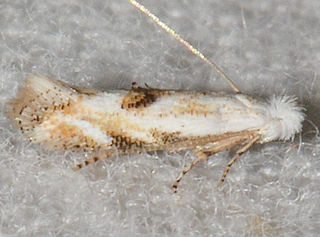Related Research Articles
Alberada parabates is a species of snout moth in the genus Alberada. It was described by Harrison Gray Dyar Jr. in 1913, and is known in North America from Arizona, California, Colorado, New Mexico, Oklahoma, Texas and Mexico.
Prorella gypsata is a moth in the family Geometridae first described by Augustus Radcliffe Grote in 1882. It is found in the US states of Colorado, New Mexico, Arizona and south-western Texas.

Bucculatrix montana is a moth in the family Bucculatricidae. It was described by Annette Frances Braun in 1920 and is found in North America, where it has been recorded from Ontario, Nova Scotia, Indiana, Maryland, Virginia, Ohio, Michigan, Maine, New York, New Jersey, Massachusetts and Georgia.
Bucculatrix koebelella is a species of moth in the family Bucculatricidae. It is found in North America, where it has been recorded from California. It was described in 1910 by August Busck.
Bucculatrix sporobolella is a moth in the family Bucculatricidae. It was described by August Busck in 1910 and is found in North America, where it has been recorded from New Mexico and California.
Bucculatrix zophopasta is a moth in the family Bucculatricidae. It was described by Annette Frances Braun in 1963 and is found in North America, where it has been recorded from British Columbia, Oregon and California.

Chrysendeton medicinalis, the bold medicine moth, is a moth in the family Crambidae. It was described by Augustus Radcliffe Grote in 1881. It is found on North America, where it has been recorded from Alabama, Florida, Georgia, Illinois, Indiana, Kentucky, Maryland, Mississippi, North Carolina, Ohio, Pennsylvania, South Carolina, Tennessee, Texas and West Virginia.
Elophila ekthlipsis, the nymphula moth, is a moth in the family Crambidae. It was described by Augustus Radcliffe Grote in 1876. It is found in North America, where it has been recorded from the Great Lakes area, including Indiana, Maine, Michigan, Minnesota, New Brunswick, New Hampshire, Ohio, Ontario, Quebec and Wisconsin. The habitat consists of ponds and marshes.
Loxostege mojavealis is a moth in the family Crambidae. It was described by Hahn William Capps in 1967. It is found in North America, where it has been recorded from the Mojave Desert in Arizona and California.
Pyrausta lethalis, the lethal pyrausta moth, is a moth in the family Crambidae. It was described by Augustus Radcliffe Grote in 1881. It is found in North America, where it has been recorded from California to southern Nevada, southern Arizona and Texas.
Pyrausta nicalis is a moth in the family Crambidae. It was described by Augustus Radcliffe Grote in 1878. It is found in North America, where it has been recorded from Quebec west to British Columbia, south to Colorado, Utah, Nevada and California.
Pyrausta socialis, the sociable pyrausta moth, is a moth in the family Crambidae. It was described by Augustus Radcliffe Grote in 1877. It is found in North America, where it has been recorded from Ontario west to British Columbia, south to Montana and Colorado.
Pyrausta tatalis is a moth in the family Crambidae. It was described by Augustus Radcliffe Grote in 1877. It is found in North America, where it has been recorded from California to Texas and Oklahoma.

Compacta capitalis is a moth in the family Crambidae. It was described by Augustus Radcliffe Grote in 1881. It is found in North America, where it has been recorded from Maryland to Florida, west to Texas and possibly Colorado, north to Illinois.
Loxomorpha flavidissimalis is a moth in the family Crambidae. It was described by Augustus Radcliffe Grote in 1877. It is found in the United States, where it has been recorded from Texas, Florida, North Carolina and West Virginia. It is also found in Mexico and Puerto Rico. It has also been recorded from Australia.
Mecyna submedialis, the orange-toned mecyna moth, is a moth in the family Crambidae. It was described by Augustus Radcliffe Grote in 1876. It is found in North America, where it has been recorded from Ontario and Michigan, south to Florida and west to Arkansas. It has also been recorded from Alberta.
Udea octosignalis is a moth in the family Crambidae. It was described by George Duryea Hulst in 1886. It is found in North America, where it has been recorded from California and Texas.
Apachea barberella is a moth in the family Depressariidae, and the only species in the genus Apachea. It was described by August Busck in 1902. It is found in North America, where it has been recorded from Montana, Colorado, New Mexico, Arizona, Utah and California.

Eucosma abstemia is a species of moth of the family Tortricidae first described by Edward Meyrick in 1932. It is found in the United States, where it has been recorded from Colorado, Arizona and California.

Lacinipolia dimocki is a moth in the family Noctuidae. It is found on the eastern slope of the Washington Coast Ranges to southern California.
References
- ↑ Nuss, M.; et al. (2003–2014). "GlobIZ search". Global Information System on Pyraloidea. Retrieved July 15, 2014.
- ↑ "801090.00 – 4916 – Prorasea simalis – Grote, 1878". North American Moth Photographers Group. Mississippi State University. Retrieved August 9, 2018.
- ↑ Grote, A. R. (1878). "Preliminary studies of the North American Pyralidae". Bulletin of the United States Geological and Geographical Survey of the Territories. 4: 669.
| This Evergestinae-related article is a stub. You can help Wikipedia by expanding it. |